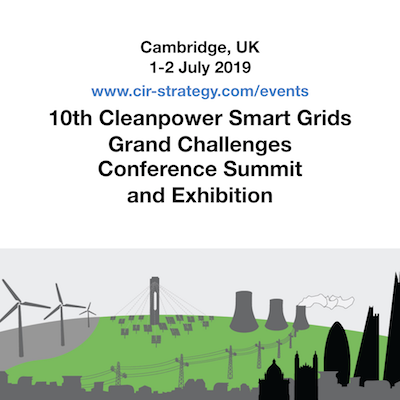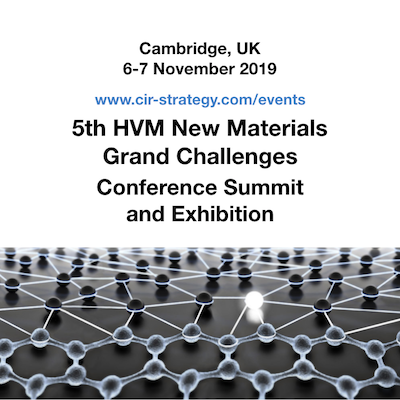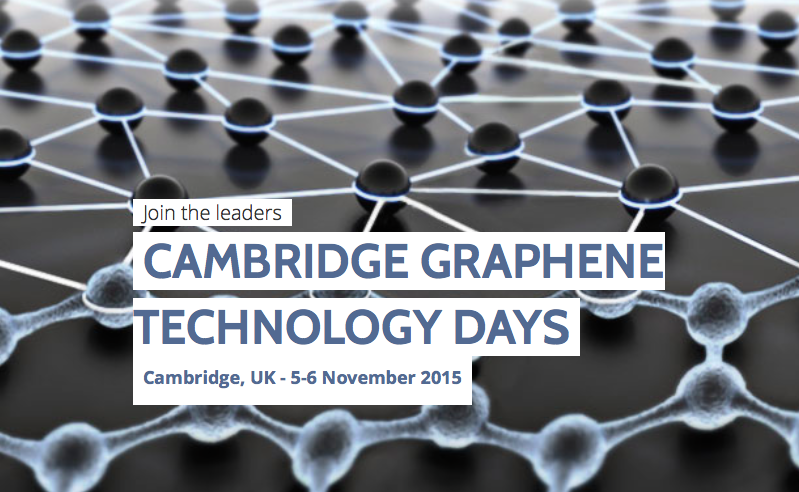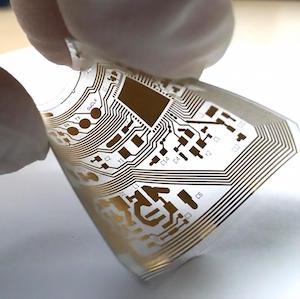Summit Guide: 10th anniversary Cleanpower Smart Grids Conference 2019
Events home: www.cir-strategy.com/events
Direct fast tickets: https://mysplink.com/cir/shop
Formal Registration: http://www.cir-strategy.com/c4ir/cpsg19/register/#shop
1 July Day 1 – Technology Executive Briefing Day 10:30am – 4:30pm
10.30-11.00 Registration and networking
Session 1 11.00-13.00 Introduction to clean power and smart grid energy systems
11.00 – 11.15 Gavin Jones – Chair’s Opening Remarks
11.15 – 11.45 Erwin Frank-Schultz, IBM, CTO Energy, Environment and Utilities “Energy Systems and Digital Twins”
11.45 – 12.00 Mash-Hud Iqbal, Partner, Marks and Clerk “IPR and Energy innovation”
12.00 – 12.10 David Richardson, Innovation Lead – Energy Systems, InnovateUK “PFER Programme and smart local energy systems design”
12.10 – 12.35 Sylvain Vittecoq, CTO, CyanConnode “The benefits of RF mesh networks for smart metering, smart grid and IoT”
12.35 – 13.00 Discussion & Q&A
led by Gavin Jones
13.00 – 14.00 Lunch
Session 2 14.00 – 15.15 Energy storage & battery technologies
14.00 – 14.20 Professor Vasant Kumar, Cambridge University “A brief sprint through battery science”
14.20 – 14.40 Dr Rumen Tomov, CJET Ltd “Novel storage and battery materials”
14.40 – 15.00 Daniella Sanchez-Lopez, Cambridge University Research Fellow, “Li supply chains and battery tech”
15.00 – 15.15 Panel moderated by Professor Vasant Kumar, Cambridge University Materials Science, leading battery scientist and author, with Ian Ellerington, The Faraday Institution & and the Space Catapult (invited) Mining Li in Cornwall (panellist)
Tea break 15.15 – 15.45
Session 3 15.45 – 17.00 Data, ML & security technology
15.45 – 15.55 Mike Handley, PolyChord, “A grounding in ML”
15.55 – 16.05 Eric Topham, Business Development, T-DAB “The ML Use Case for Energy Optimisation”
16.05 – 16.20 Dr Natalie Lowery, Energy Systems Catapult “Modelling Energy Systems”
16.20 – 16.40 Dr Andrew Tsonchev, Director of Technology, Darktrace Industrial, “Using AI for Real-Time Threat Detection across OT & IT”
16.40 -17.00 Session Q&A led by Gavin Jones
16.55 Close for Day
18.30 – 21.00 Dinner evening
18.30 reception drinks networking for 19.00 – 21.00 Dinner hosted by CIR at Christ’s College Cambridge
Day 2 – Innovation Conference 09:00 – 17:00
09.00 – 09.30 Registration and networking
Session 1 09.30 – 11.00 Introduction: energy system futures and innovation and threats
09.30 – 09.40 Conference Introduction & Chair’s Introduction: Jeremy Nicholson, Alfa Energy Corporate Affairs & VP/Chair IFIEC Europe
09.40 – 10.00 Richard Smith, Head of Commercial, National Grid – “Operating the GB transmission system, carbon free, by 2025: opportunities/challenges”
10.00 – 10.15 Anser Shakoor, ABB, “Future of the energy systems mix”
10.15 – 10.30 Victoria Doherty, QinetiQ, “Power, storage and human factors in cybersecurity”
10.30 – 10.50 Emily Orton, CMO, Darktrace, “Cybersecurity and energy infrastructure and devices” Keynote
10.50 – 11.10 Panel with moderator Pamela Taylor, Taylor Macpherson
Coffee break 11.00 – 11.40
Session 2 11.40 – 13.00 Grids, connectivity innovation
11.40 – 12.00 Dr Sean Cochrane, Head of Technical Sales, CyanConnode, “Commercialising an IoT communication platform”
12.00 – 12.15 Nick Merricks, Landis+Gyr, “Grid edge intelligence in the smart grid”, securely.”
12.15 – 12.30 Moixa Energy, CEO Simon Daniel “Connectivity and energy management of smart grids and off grids”
12.30 – 12.40 Jim Lott, Technical Lead – Energy Systems Catapult “Prospering from the Energy Revolution”
12.40 – 13.00 Panel with moderator Gavin Jones and panellist Jane Lucy, CEO, Labrador
13.00 – 14.00 Lunch Networking
14.00 – 15.20
Session 3 Storage / battery innovation and commercialisation
14.00 – 14.05 Ian Ellerington, Head of Tech Transfer, The Faraday Institution – “Introduction & the importance of storage”
14.05 – 14.20 Richard Druce, Associate Director of Energy, Environment & Infrastructure, NERA “Distributed energy resources and how to monetise them”
14.20 – 14.35 Georgina Dingley, Business Development, Anesco, “Utility scale energy storage”
14.35 – 14.45 Dr Gleb Ivanov, CEO, Sigma Lithium “Anode technology for advanced energy storage, Li primary and rechargeable batteries”
14.45 – 15.00 Dr Athan Fox, CEO, Aurelius Environmental “Out of the furnace and into the leaching tank”
15.00 – 15.20 Panel moderated by Isobel Sheldon, UK Battery Industrialisation Centre (confirmed)
Tea break 15.20 – 15.45
Session 4 Clean energy policy & strategy – final panel
15.45 – 17.00
15.45 – 16.00 Centrica/SSE Strategy/Grids Speaker tbc
16.00 – 16.15 Sally Fenton MA, Innovation Manager, Dept of BEIS, “Delivering innovation to the Grand Challenge of Clean Growth”
16.15 – 16.30 Akshay Kaul, Director, Systems & Networks, Ofgem
16.30 – 16.55 Panel with moderator Judith Ward, Sustainability First
16.55 – 17.00 Chair closing remarks by Jeremy Nicholson, Alfa Energy and Gavin Jones
CLOSE OF EVENT
2019 Advisory Committee – CPSG
Dr Justin Hayward MBA, CIR (Executive Chair)
Maxine Frerk, Grid Edge Policy
Gavin Jones
Jeremy Nicholson, Alfa Energy & VP Chair IFIEC Europe
Professor Vasant Kumar, Cambridge University
Ian Ellerington, Head of Tech Transfer, Faraday Institution






